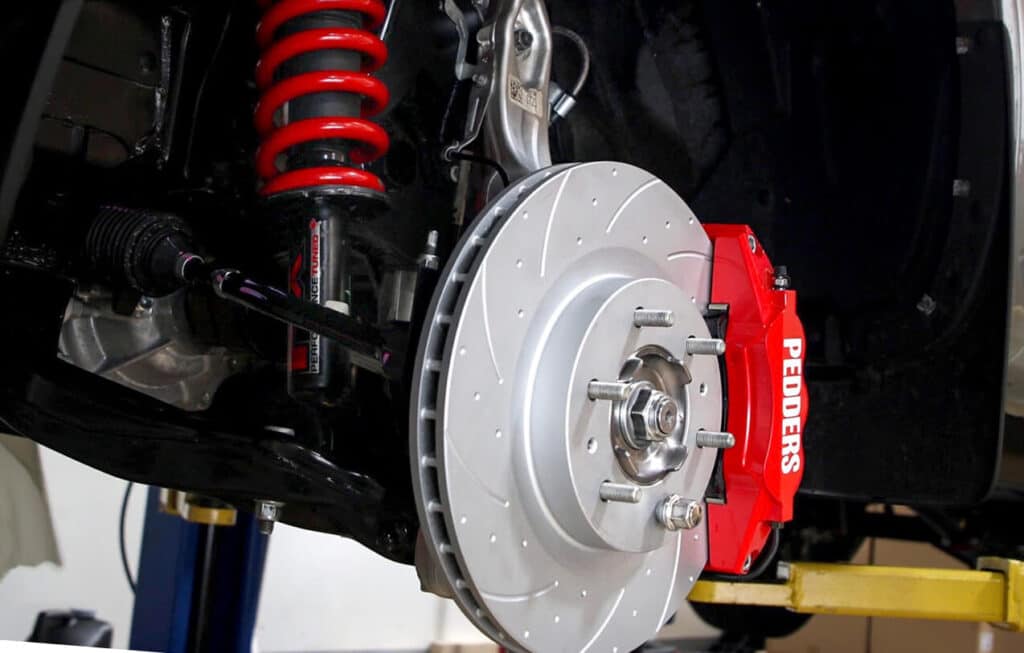The Importance of Reliable Brakes for Off-Roading
When venturing off the beaten path, reliable brakes are crucial to ensure the safety and performance of your off-road vehicle. Off-roading presents unique challenges for a vehicle’s braking system, making it necessary to consider brake system upgrades specifically designed for off-road conditions. This article will discuss how off-roading affects your vehicle’s brakes, essential brake system upgrades for off-road performance, and tips for maximizing brake performance in off-road scenarios.
How Off-Roading Challenges Your Vehicle’s Braking System
Increased Heat Generation: Off-roading often involves steep inclines, rough terrain, and frequent braking, which can generate significant heat in your vehicle’s brake components. Over time, excessive heat can lead to brake fade, reduced stopping power, and potential damage to brake components.
Exposure to Dust, Mud, and Water: Off-road conditions expose your braking system to dust, mud, and water, which can compromise brake performance. These contaminants can accumulate on brake components, reducing friction and stopping power.
Additional Strain from Larger Tires and Added Weight: Off-road vehicles often feature larger tires and added weight from aftermarket upgrades like skid plates and winches. These modifications can place additional strain on your vehicle’s braking system, demanding more stopping power and heat dissipation capabilities.

Essential Brake System Upgrades for Off-Road Performance
High-Performance Brake Pads: Upgrading to high-performance brake pads designed for off-road conditions can enhance stopping power and heat resistance. These pads often feature more aggressive friction materials that provide better bite and fade resistance under extreme conditions.
Upgraded Brake Rotors: Larger, slotted, or vented brake rotors can improve heat dissipation and reduce brake fade. These rotors are designed to handle the increased heat generated during off-roading and help maintain consistent braking performance.
Braided Stainless Steel Brake Lines: Replacing your vehicle’s rubber brake lines with braided stainless steel lines can improve brake pedal feel and responsiveness. Stainless steel lines are more resistant to swelling and expansion under pressure, ensuring consistent brake pressure during off-road adventures.
Additional Brake System Enhancements for Off-Roading
Big Brake Kits: Big brake kits typically include larger calipers, rotors, and pads, providing increased stopping power and heat dissipation capabilities. These kits are ideal for vehicles with larger tires or significant weight increases from off-road modifications.
Hydraulic Brake Boosters: Upgrading to a hydraulic brake booster can enhance brake pedal feel and responsiveness, especially in off-road vehicles with larger tires or added weight. Hydraulic boosters provide more consistent brake pressure and can help compensate for increased demands on your braking system.
Brake Cooling Systems: Brake cooling systems, such as air ducts or cooling fins, can help dissipate heat generated during off-roading. These systems direct cool air onto brake components, reducing brake fade and improving overall braking performance.
Selecting the Right Brake Components for Your Off-Road Vehicle
Assessing Your Off-Roading Needs: Consider the type of off-roading you plan to do, such as rock crawling, desert racing, or trail riding. Different off-road conditions may require specific brake system upgrades to optimize performance and durability.
Vehicle Compatibility and Performance Requirements: Ensure that any brake system upgrades are compatible with your vehicle’s make, model, and suspension setup. Consult your vehicle’s manufacturer or an off-road specialist for guidance on selecting the right components.
Evaluating Upgrade Costs and Benefits: Weigh the costs and benefits of various brake system upgrades, considering factors like improved performance, safety, and component longevity. Some upgrades may offer more significant advantages than others, depending on your specific off-roading needs and budget constraints.
Installing and Maintaining Your Off-Road Brake System
Proper Installation Techniques: Ensure that all brake system upgrades are installed correctly to maximize performance and safety. Professional installation is recommended, especially for complex components like big brake kits or hydraulic brake boosters.
Break-In Procedures for New Brake Components: Follow the manufacturer’s recommended break-in procedures for new brake components, which typically involve a series of moderate and hard stops to properly bed the pads and rotors. This process helps ensure optimal braking performance and component longevity.
Regular Inspection and Maintenance: Regularly inspect and maintain your off-road brake system, including checking for wear or damage to brake components, monitoring brake fluid levels, and ensuring proper function. Periodic maintenance can help prolong the life of your brake system and maintain optimal performance in off-road conditions.
Off-Roading Brake Techniques: How to Maximize Brake Performance
Engine Braking and Downshifting: Utilize engine braking and downshifting to reduce the load on your vehicle’s brakes, particularly when descending steep inclines. This technique can help maintain brake performance and reduce the risk of brake fade.
Threshold Braking: Practice threshold braking, which involves applying steady, firm pressure to the brake pedal without activating the anti-lock braking system (ABS). This technique can help you maintain control of your vehicle and optimize braking performance in off-road situations.
Left-Foot Braking: Left-foot braking, where the driver uses their left foot to apply the brake while maintaining throttle input with their right foot, can improve vehicle control and stability in certain off-road scenarios. This technique can be particularly useful during high-speed maneuvers or when navigating tight turns.

Understanding the Limitations of Your Off-Road Brakes
Be aware of the limitations of your off-road brake system and adjust your driving style accordingly. Even with upgraded components, off-road conditions can still challenge your vehicle’s brakes, and understanding these limitations can help you avoid potential accidents or component failures.
The Importance of Vehicle Balance and Suspension for Off-Road Braking
A well-balanced vehicle and proper suspension setup are essential for effective off-road braking. Ensure that your off-road vehicle’s suspension is tuned for optimal weight distribution and handling, which can help improve braking performance and reduce stress on brake components.
Conclusion: Equip Your Off-Road Vehicle with a High-Performing Brake System
A reliable and high-performing brake system is essential for safe and enjoyable off-roading experiences. By understanding the unique challenges that off-roading presents for your vehicle’s brakes and selecting the appropriate upgrades, you can enhance braking performance, safety, and overall enjoyment during your off-road adventures. Regular inspection and maintenance, coupled with the proper driving techniques, will help ensure that your off-road brake system remains in top condition, allowing you to tackle even the most demanding off-road terrain with confidence.
